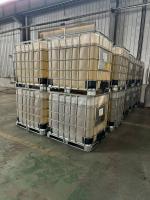Our Products
Water Treatment Chemicals / polydadmac of kemsep C-9014 C-9015 C-9016 can be replaced by Chinafloc--Polydadmac


polydadmac of kemsep C-9014 C-9015 C-9016 can be replaced by Chinafloc--Polydadmac
polydadmac of kemsep C-9014 kemsep C-9015 kemsep C-9016 are three models of with low high molecular weight and low and high solid content.mainly used for water treatment and sludge dewatering,Chinafloc-polydadmac can replace of them with good result.
PolyDADMAC, short for Polydiallyldimethylammonium Chloride, is a cationic polymer widely used in water treatment and sludge dewatering. It is known for its high charge density, making it extremely effective in flocculating and coagulating particles. Here's a detailed look at how PolyDADMAC is utilized in these areas:
Water Treatment
In water treatment, PolyDADMAC serves several pivotal roles, primarily focusing on its ability to coagulate and flocculate suspended solids, reduce turbidity, and remove organic matter. Here’s how it works in various stages of water purification:
1. Coagulation and Flocculation
PolyDADMAC is added to water to promote coagulation, which is the process of destabilizing particles in the water so they can clump together. As a flocculant, PolyDADMAC helps aggregate these destabilized particles into larger flocs (clusters), which can be more easily removed by sedimentation or filtration. The effectiveness of PolyDADMAC in coagulation and flocculation is due to its strong cationic nature, which allows it to bind efficiently with negatively charged particles in the water.
2. Clarification
During the clarification process, PolyDADMAC enhances the removal of suspended solids, leading to clearer water. This clarity is crucial for subsequent filtration processes and ensures that the final water supply is clean and free of turbidity, which is essential for both potable water and industrial applications.
3. Removal of Organic Contaminants
PolyDADMAC is highly effective at removing dissolved organic compounds, which include natural organic matter that can cause color and undesirable flavors in water. It interacts with these compounds, facilitating their aggregation into flocs that can be removed more efficiently from the water.
4. Disinfection
While PolyDADMAC itself is not a disinfectant, it significantly aids the disinfection process by reducing the organic load and turbidity of the water. This allows disinfectants like chlorine to be more effective, as there are fewer contaminants to react with, thus improving the overall safety of the water.
Sludge Dewatering
In the context of sludge dewatering, PolyDADMAC is used primarily to condition sludge before it undergoes mechanical dewatering processes. Here’s how PolyDADMAC contributes to this important phase of wastewater treatment:
1. Sludge Conditioning
Before dewatering, sludge is often chemically conditioned to improve the separation of solids from liquids. PolyDADMAC is added to the sludge to enhance flocculation, which is essential for effective dewatering. It alters the electrical surface charge of the sludge particles, causing them to bind together into larger, more manageable clumps or flocs.
2. Enhancement of Mechanical Dewatering
During mechanical dewatering processes such as filter pressing, centrifugation, or belt pressing, PolyDADMAC-treated sludge exhibits improved dewatering performance. The flocs formed are more robust and can withstand the mechanical pressures applied during these processes, resulting in more efficient separation and a drier sludge cake. This reduction in sludge volume translates to lower disposal costs and potentially less environmental impact.
3. Reduction of Sludge Volume
By improving the dewatering efficiency, PolyDADMAC contributes to a significant reduction in the volume of sludge that needs to be handled, transported, and disposed of. This not only reduces costs associated with these activities but also mitigates the environmental burden of waste sludge management.
Environmental and Economic Benefits
Using PolyDADMAC in water treatment and sludge dewatering offers multiple environmental and economic benefits:
Reduced Chemical Dosage: PolyDADMAC is effective at lower doses compared to many other coagulants and flocculants, which can lead to cost savings and reduced chemical handling issues.
Energy Efficiency: Improved dewatering efficiency means less energy is required for pumping, heating, and treating sludge and water, contributing to overall energy conservation.
Water Reuse: By effectively removing contaminants and improving water clarity, PolyDADMAC-treated water is often of a quality that can be recycled and reused within industrial or agricultural settings, promoting sustainable water management practices.
In summary, PolyDADMAC is a cornerstone chemical in the fields of water treatment and sludge dewatering. Its ability to efficiently coagulate and flocculate particles, enhance sludge conditioning, and support environmental sustainability makes it a valuable asset in managing water resources and waste effectively.


